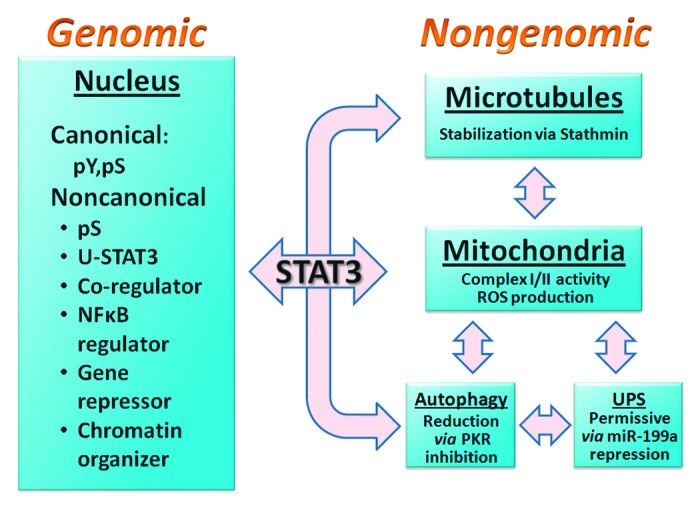
Figure 2. Scheme depicting the genomic and nongenomic actions identified for STAT3 in cardiac myocytes and other cell types. The genomic actions of STAT3 include both canonical and noncanonical events. The former involves STAT3 functioning as a transcription factor in the nucleus by binding TTN4–6AA elements in promoters and enhancing transcription. The noncanonical genomic actions of STAT3, which are diverse and not well understood, include: induction of transcription by pS727 STAT3 (without Y705 phosphorylation) and unphosphorylated STAT3 (U-STAT3); enhancing transcriptional activity of other transcription factors (e.g., nuclear steroid receptors); controlling the processing and nuclear retention of NFκB transcription factors; repressing gene expression; and modulating chromatin structure. Some of these actions may not require DNA binding and some events associated with the regulation of other transcription factors could conceivably occur in the cytoplasm. STAT3 has been shown to exert 3 actions in the cell that are extranuclear and do not involve gene transcription. These nongenomic actions of STAT3 control microtubule stability, mitochondrial function, and autophagy. For most, interaction of STAT3 with a specific protein has been implicated: stathmin (microtubule stability), GRIM19 (mitochondrial function), and PKR (autophagy). For microtubule stability and inhibition of autophagy, the STAT3–protein interaction provides a straightforward mechanistic link. The basis for the mitochondrial role of STAT3 is the least understood and other proteins besides GRIM19 are likely involved. The permissive role of STAT3 in the ubiquitin-proteasome system (UPS) is genomic and results from suppression of miR-199a expression. Understanding of crosstalk between the genomic and mitochondrial actions of STAT3 is limited, as is the likely interplay among the nongenomic actions of STAT3 (for instance, impaired mitochondrial function and enhanced autophagy/mitophagy). Evidence of complex interplay among microtubule stability, mitochondrial function, autophagy, and UPS in various cell types is reported in the literature in general, implying that STAT3 has a central role in cellular homeostasis and stress responsiveness. Differential regulation of posttranslational modifications of STAT3 could form the basis for the integration of the nongenomic and genomic actions of STAT3.
